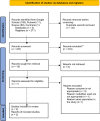Diagnostic capabilities of transperineal ultrasound (TPUS) to evaluate anal sphincter defect post obstetric anal sphincter injury (OASIS)? A systematic review
- PMID: 36630015
- PMCID: PMC10247614
- DOI: 10.1007/s40477-022-00763-3
Diagnostic capabilities of transperineal ultrasound (TPUS) to evaluate anal sphincter defect post obstetric anal sphincter injury (OASIS)? A systematic review
Abstract
Introduction: Endoanal ultrasound (3D-EAUS) is the gold standard imaging investigation for evaluating the anal sphincter; unfortunately, it is not universally available in most obstetric units. This study aims to appraise the ability of transperineal ultrasound (TPUS) compared with 3D-EAUS as the gold standard to identify anal sphincter defects after primary repair of OASIS.
Methods: A systematic search of major databases to identify diagnostic accuracy of 3D-TPUS in evaluating anal sphincter defects. Preferred Reporting Items for Systematic Reviews and Meta-Analyses (PRISMA) guidelines were designed for this systematic review. The risk of bias and applicability concerns were assessed using the QUADAS-2 tool. Our eligibility criteria are patients with a history of primary repair of anal sphincter injuries (OASIS). They were followed up after the primary repair to detect the anal sphincter defect using 3D-TPUS vs. 3D-EAUS as a gold standard.
Results: Two eligible observational studies were included and assessed for risk of bias using the QUADAS-2 tool and showed a low risk of bias and a low risk of concerns. 3D-TPUS had various sensitivity to detect external anal sphincter defects in two studies; meanwhile, the specificity was around 67-70%. For detecting the internal anal sphincter defects, 3D-TPUS had low sensitivity but high specificity (93-94%).
Conclusion: 3D-TPUS had various sensitivity to detect external anal sphincter defects and low sensitivity to detect internal anal sphincter defects. On the other hand, 3D-TPUS had low specificity for detecting external anal sphincter defects and high specificity for detecting internal anal sphincter defects.
Keywords: 3D endoanal ultrasound; 3D transperineal ultrasound; Anal sphincter defect; OASI; Perineal rupture; Ultrasound.
© 2023. The Author(s).
Conflict of interest statement
There is nothing to declare.
Figures
References
-
- Sultan AH. Editorial: Obstetrical perineal injury and anal incontinence. Clin Risk. 1999;5(6):193–196. doi: 10.1177/135626229900500601. - DOI
-
- Abrams P, Cardozo L, Khoury S, Wein A. Assessment and Conservative Management of Faecal Incontinence and Quality of Life in Adults. In: 5th International Consultation on Incontinence. Paris; 2013. p. 1443–86.
Publication types
MeSH terms
LinkOut - more resources
Full Text Sources




